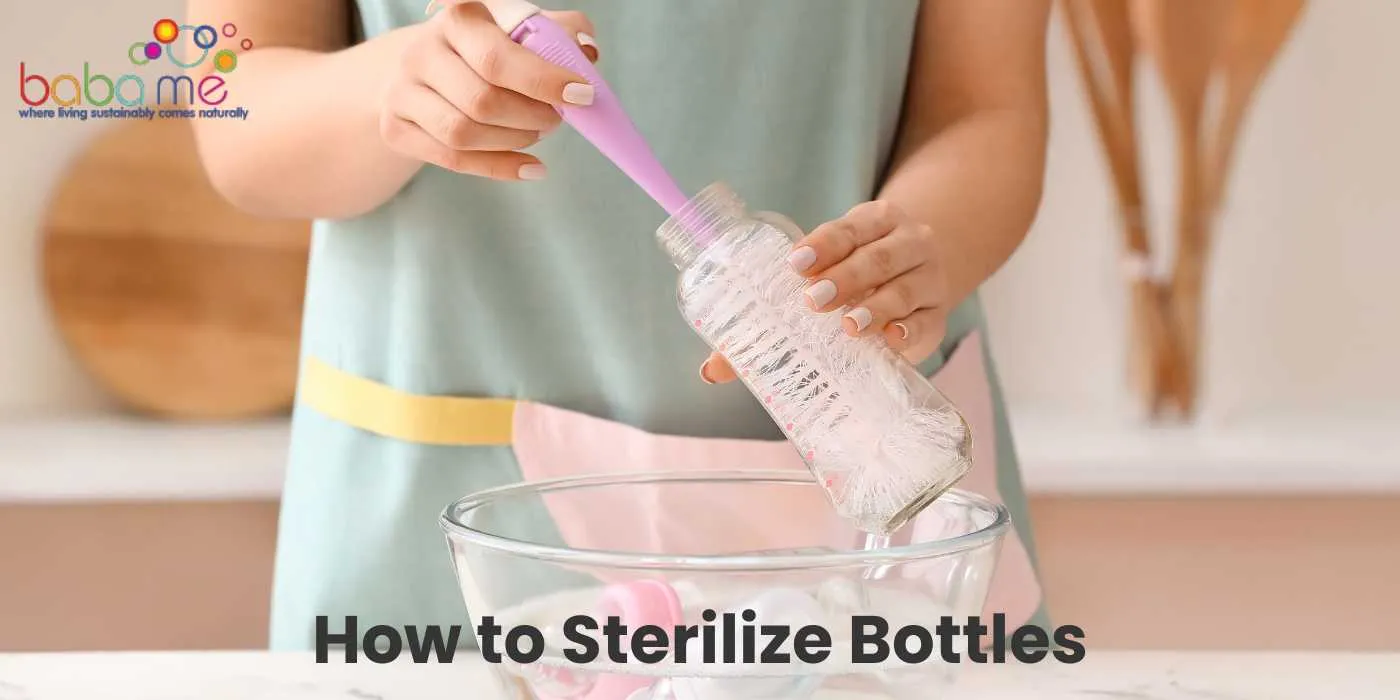Baby bottles are more than just feeding tools – they’re a direct gateway to your baby’s health. As such, ensuring these bottles are free from harmful germs is paramount.
Sterilization, a process much more thorough than your regular cleaning, eradicates potential threats, offering peace of mind with every feed.
Dive in to learn the best practices for sterilizing bottles, be it through boiling, specialized equipment, or alternative methods.
Key Takeaways
Sterilizing bottles is crucial for ensuring your baby’s health and safety.
There are various methods for sterilizing bottles, including boiling and using a steam sterilizer.
It’s important to sterilize all bottle components and practice post-sterilization care to maintain a clean and safe environment for your baby.
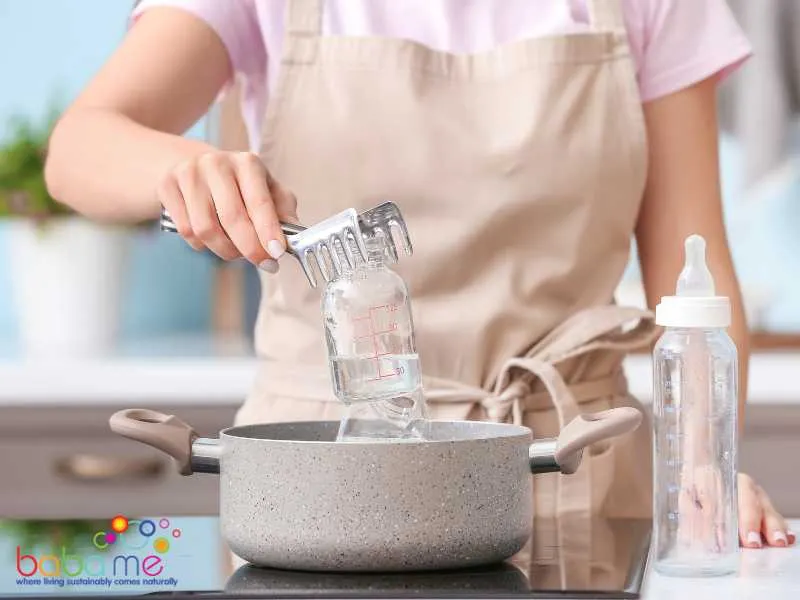
Preparation for Sterilization
Before you start sterilizing your baby’s bottles, it’s essential to make sure they are clean. Follow these steps to prepare the bottles for sterilization:
Disassemble the bottles: Take apart all parts of the bottle, including the nipple, ring, and cap. This will make it easier to clean and sterilize each part thoroughly.
Clean the bottles: Wash all parts of the bottle with soap and water. Use a bottle brush to scrub the inside of the bottle and nipple. Pay attention to any crevices or hard-to-reach areas. Rinse all parts with water to remove any soap residue.
Inspect the bottles: Check each part of the bottle for any cracks, chips, or other damage. If you find any damage, discard the part and replace it with a new one. Damaged bottles can harbor bacteria and other harmful substances that can harm your baby.
Dry the bottles: Allow all parts of the bottle to air dry completely before sterilizing. You can also use a clean towel to dry the bottles, but make sure the towel is clean and free of any bacteria or other contaminants.

Sterilization Methods
When it comes to sterilizing baby bottles, there are several methods to choose from. Each method has its own pros and cons, so you should choose the one that works best for you and your family.
Boiling
Boiling is a classic and effective way to sterilize baby bottles. To do it, take all the pieces of the bottle apart and place them in a pot of boiling water for at least 5 minutes. Make sure that all the parts are completely submerged in the water.
After boiling, remove the parts and let them air dry on a clean towel. Boiling is a great option if you don’t have access to a dishwasher or a bottle sterilizer.
Dishwasher
If you have a dishwasher, you can use it to sterilize baby bottles. Make sure that the bottles are dishwasher-safe and placed on the top rack. Use the hot water and high-temperature cycle to ensure that the bottles are properly sterilized.
After the cycle is complete, remove the bottles and let them air dry on a clean towel. Keep in mind that not all dishwashers have a high-temperature cycle, so check your manual before using this method.
Microwave
Microwaving is another option for sterilizing baby bottles. You can use a microwave steam sterilizer or a microwave-safe container filled with water. Place the bottles in the sterilizer or container and microwave on high for at least 2 minutes.
After microwaving, let the bottles cool down before removing them from the sterilizer or container. Microwaving is a quick and convenient way to sterilize baby bottles, but make sure to follow the instructions carefully to avoid damaging the bottles.
Chemical Sterilization
Chemical sterilization is a method that involves using a solution to sterilize baby bottles. You can use a commercial sterilizing solution or make your own solution using household bleach. To make your own solution, mix 1 teaspoon of bleach with 1 liter of water.
Soak the bottles in the solution for at least 5 minutes, then rinse them thoroughly with water. Chemical sterilization is a good option if you don’t have access to a stove or a microwave.
Bottle Sterilizer
A bottle sterilizer is a device that uses steam to sterilize baby bottles. You can choose from electric or microwave sterilizers, depending on your preference. To use an electric sterilizer, add water to the device and place the bottles inside.
Turn on the sterilizer and wait for the cycle to complete. To use a microwave sterilizer, add water to the sterilizer and place it in the microwave. Microwave on high for the recommended time, then let it cool down before removing the bottles. A bottle sterilizer is a convenient and efficient way to sterilize baby bottles.
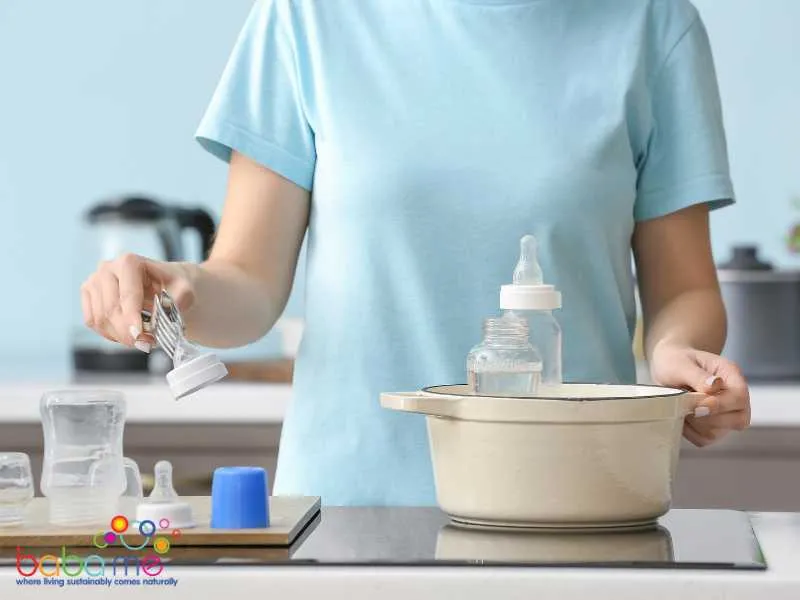
Post-Sterilization Care
After sterilizing your baby’s bottles, it’s important to take care of them properly to prevent recontamination. Here are some tips for post-sterilization care:
Let them cool down and then remove them from the sterilizer. It’s important to dry them properly to prevent moisture buildup, which can lead to the growth of bacteria. You can dry them using a clean cloth or by air-drying them.
Air-drying is the best method for drying your baby’s bottles after sterilization. Place the bottles and their parts on a clean, dry surface and let them air-dry completely. Avoid using a towel or cloth to dry the bottles, as this can introduce contaminants.
Once the bottles are dry, cover them with a clean, dry cloth or lid to protect them from dust and other contaminants. This will help keep them clean until you’re ready to use them.
Store the bottles in a clean, dry place until you’re ready to use them. Avoid storing them in a damp or humid environment, as this can encourage the growth of bacteria.
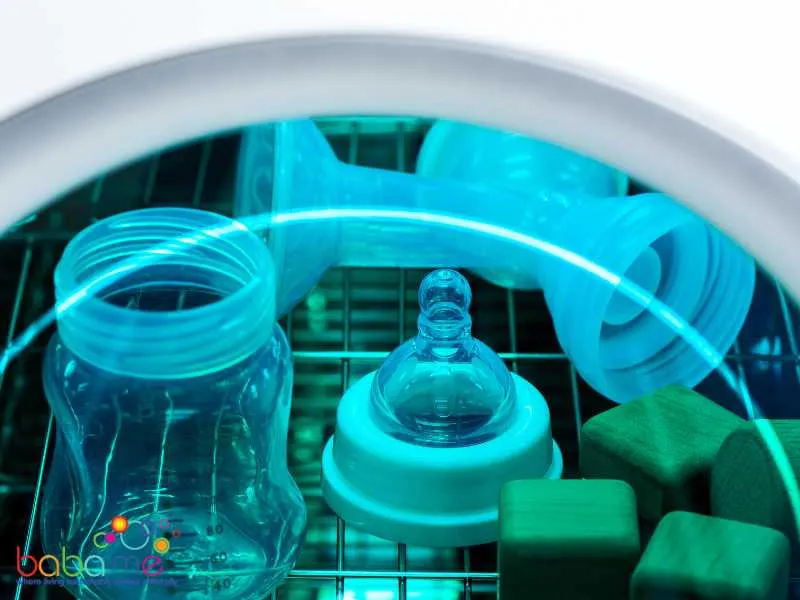
Choosing the Right Sterilization Method
When it comes to sterilizing bottles, there are several methods to choose from. The method you choose will depend on the type of bottle you have and your personal preference. In this section, we will discuss the different sterilization methods available to help you choose the right one for you and your baby.
Boiling
Boiling is a traditional and effective way to sterilize bottles. It is suitable for both glass and plastic bottles. To use this method, disassemble the bottle and place all the parts in a pot of boiling water for at least 5 minutes. Boiling is a quick and straightforward method that requires no special equipment.
Microwave Sterilization
Microwave sterilization is a quick and efficient way to sterilize bottles. It is suitable for both glass and plastic bottles. To use this method, fill the bottle with water and place it in the microwave for the recommended time. Be sure to follow the manufacturer’s instructions carefully to avoid damaging the bottle or microwave.
Electric Steam Sterilization
Electric steam sterilization is a convenient and effective way to sterilize bottles. It is suitable for both glass and plastic bottles. To use this method, place the disassembled bottle in the sterilizer, add water, and turn it on. The sterilizer will use steam to kill germs and bacteria in the bottle. Electric steam sterilizers are easy to use and require no supervision.
Chemical Sterilization
Chemical sterilization is a method that uses chemicals to sterilize bottles. It is suitable for both glass and plastic bottles. To use this method, you will need to purchase a sterilizing solution or tablets. Ensure when soaking nippes and bottles that no air bubbles are trapped in any of the bottle parts or infant feeding items.
UV Sterilization
UV sterilization is a new and innovative way to sterilize bottles. It is suitable for both glass and plastic bottles. To use this method, place the disassembled bottle in the sterilizer and turn it on. The sterilizer will use UV light to kill germs and bacteria in the bottle. UV sterilizers are easy to use and require no supervision.

Knowing When to Sterilize Bottles
Sanitizing baby bottles answer depends on a few factors, such as the age of your baby, the type of water you use, and whether the bottles are brand new or borrowed.
If you have brand new bottles, it’s important to sterilize them before the first use. This ensures that any bacteria or germs that may have accumulated during the manufacturing and packaging process are eliminated. You can use a baby bottle sterilizer or boil the bottles in water for five minutes to achieve the same result.
For babies under three months old, preemies, or babies with weakened immune systems, it’s a good idea to sterilize their bottles after each use. This helps prevent the spread of germs and reduces the risk of infections. You can use a baby bottle sterilizer or boil the bottles in water for five minutes to achieve this.
If your baby is premature or has a weakened immune system, you may need to sterilize their bottles after each use. This ensures that any bacteria or germs that may have accumulated during feeding are eliminated.
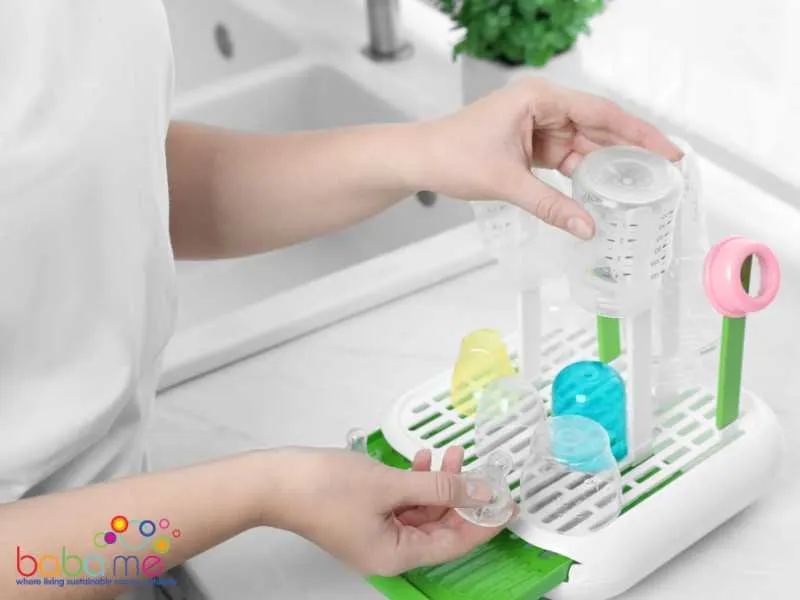
When to Stop Sterilizing Baby Bottles
When it comes to sterilizing baby bottles, many parents wonder when it’s safe to stop. Here’s what you need to know:
During the initial months of a baby’s life, their immune system is still developing, making them more susceptible to infections. It’s recommended to sterilize baby bottles, nipples, and all feeding equipment like sippy cups for at least the first year of life to ensure that any potential harmful bacteria are killed. You should also ensure regular cleaning of the high chair as well. This is especially crucial during the first six months when the baby is exclusively on a liquid diet.
However, as babies grow, begin to crawl, and put various objects in their mouths, they are exposed to more germs, which can help build their immune system. Once your baby reaches the age of 1 year and starts eating solid foods, their immune system is better equipped to handle potential bacteria.
After the first year, it’s still important to thoroughly clean bottles after each use. While sterilizing might not be as necessary as before, ensuring the bottles are cleaned with hot, soapy water and air-dried can help prevent bacterial growth. Always check bottles and nipples for any signs of wear, cracks, or mold, as these can harbor bacteria.
If your child has been sick, it’s a good idea to sterilize their bottles again, even after the one-year mark, to avoid any potential re-infection. This is part of disinfecting a house after illness and should be done, along with disinfecting all the toys.
Final Thoughts
Sterilising your baby’s bottle is essential, especially if your baby was born prematurely. Sterilize baby’s bottles to eliminate harmful germs, ensuring safe bottle feeding. First, clean baby bottles using bottle brushes in a clean wash basin, not the sink, to avoid contamination.
Glass bottles or older plastic bottles can be boiled, while others might benefit from a heated drying cycle in a dishwasher with a sanitizing setting. If you don’t have a sterilizer, consider using a mixture of cold water and unscented bleach.
After sterilizing all the bottle parts, including nipples and rings, use clean tongs to remove them. Let the bottles air dry on a clean dish towel, avoiding wiping them. Store baby bottles in a clean area, and if breast milk from a partially used bottle remains, ensure it’s properly stored or discarded.
FAQS on Sterilizing baby bottles
What is the best way to sterilize bottles?
The best way to sterilize bottles depends on your available resources and preferences. Common methods include boiling, using an electric or microwave sterilizer, or using chemical sterilizing solutions. Ensure all bottles, nipples, and other accessories are washed with soap and warm water before sterilizing.
Is it better to boil or sterilize baby bottles?
Boiling is a form of sterilization. Boiling baby bottles in water for at least 10 minutes effectively kills harmful bacteria and germs. Electric or microwave sterilizers are also effective and might be more convenient for some parents since they can sterilize multiple bottles at once and often take less time than boiling.
Is it safe to boil plastic baby bottles?
Most modern plastic baby bottles are designed to be boiled and are made from heat-resistant materials. However, always check the manufacturer’s instructions before boiling, as continuous exposure to high temperatures might cause some bottles to warp or become misshapen over time. If you have concerns or are using older bottles, consider using an electric or microwave sterilizer instead.
Do you have to sterilize bottles between every use?
During the first year, especially the initial months, it’s recommended to sterilize bottles between every use to ensure any potential harmful bacteria are killed. As the baby grows and their immune system strengthens, it’s typically sufficient to wash bottles with hot, soapy water between uses and sterilize them periodically. After sickness or if the bottle has been left out for an extended period, it’s a good practice to sterilize it again. Always consult with a pediatrician if you’re unsure about the frequency of sterilization.

